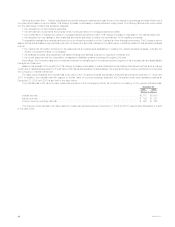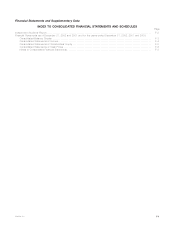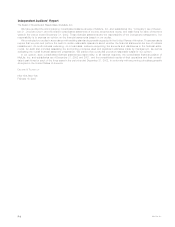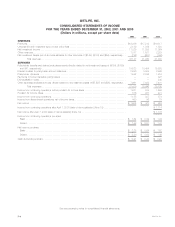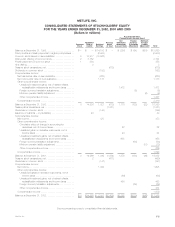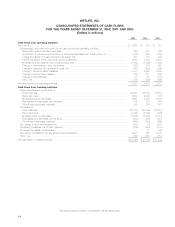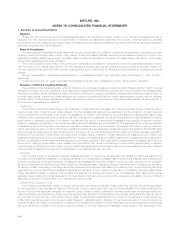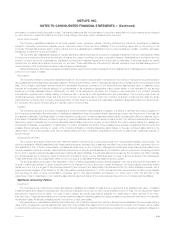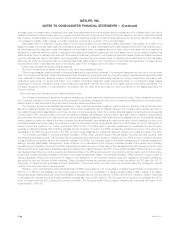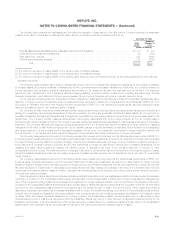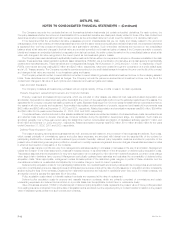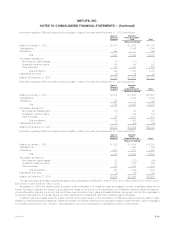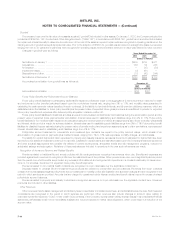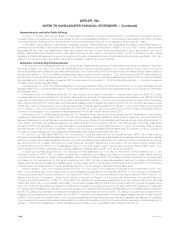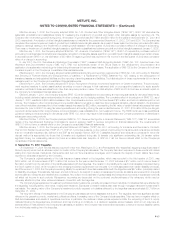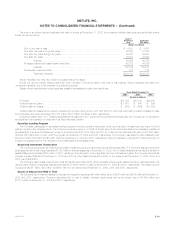MetLife 2002 Annual Report Download - page 54
Download and view the complete annual report
Please find page 54 of the 2002 MetLife annual report below. You can navigate through the pages in the report by either clicking on the pages listed below, or by using the keyword search tool below to find specific information within the annual report.METLIFE, INC.
NOTES TO CONSOLIDATED FINANCIAL STATEMENTS — (Continued)
are based upon the present value of expected future cash flows discounted at the loan’s original effective interest rate or the collateral value if the loan is
collateral dependent. Interest income earned on impaired loans is accrued on the principal amount of the loan based on the loan’s contractual interest
rate. However, interest ceases to be accrued for loans on which interest is generally more than 60 days past due and/or where the collection of interest is
not considered probable. Cash receipts on impaired loans are recorded as a reduction of the recorded asset.
Real estate held-for-investment, including related improvements, is stated at cost less accumulated depreciation. Depreciation is provided on a
straight-line basis over the estimated useful life of the asset (typically 20 to 40 years). Real estate held-for-sale is stated at the lower of depreciated cost or
fair value less expected disposition costs. Real estate is not depreciated while it is classified as held-for-sale. Cost of real estate held-for-investment is
adjusted for impairment whenever events or changes in circumstances indicate the carrying amount of the asset may not be recoverable. Impaired real
estate is written down to estimated fair value with the impairment loss being included in net investment gains and losses. Impairment losses are based
upon the estimated fair value of real estate, which is generally computed using the present value of expected future cash flows from the real estate
discounted at a rate commensurate with the underlying risks. Real estate acquired upon foreclosure of commercial and agricultural mortgage loans is
recorded at the lower of estimated fair value or the carrying value of the mortgage loan at the date of foreclosure.
Policy loans are stated at unpaid principal balances.
Short-term investments are stated at amortized cost, which approximates fair value.
Other invested assets consist principally of leveraged leases and funds withheld at interest. The leveraged leases are recorded net of non-recourse
debt. The Company participates in lease transactions which are diversified by geographic area. The Company regularly reviews residual values and writes
down residuals to expected values as needed. Funds withheld represent amounts contractually withheld by ceding companies in accordance with
reinsurance agreements. For agreements written on a modified coinsurance basis and certain agreements written on a coinsurance basis, assets
supporting the reinsured policies and equal to the net statutory reserves are withheld and continue to be legally owned by the ceding companies. The
Company recognizes interest on funds withheld in accordance with the treaty terms as investment income is earned on the assets supporting the
reinsured policies.
Structured Investment Transactions and Variable Interest Entities
The Company participates in structured investment transactions, primarily asset securitizations and structured notes. These transactions enhance
the Company’s total return of the investment portfolio principally by generating management fee income on asset securitizations and by providing equity-
based returns on debt securities through structured notes and similar type instruments.
The Company sponsors financial asset securitizations of high yield debt securities, investment grade bonds and structured finance securities and
also is the collateral manager and a beneficial interest holder in such transactions. As the collateral manager, the Company earns management fees on
the outstanding securitized asset balance, which are recorded in income as earned. When the Company transfers assets to a bankruptcy-remote special
purpose entity (‘‘SPE’’) and surrenders control over the transferred assets, the transaction is accounted for as a sale. Gains or losses on securitizations
are determined with reference to the carrying amount of the financial assets transferred, which is allocated to the assets sold and the beneficial interests
retained based on relative fair values at the date of transfer. Beneficial interests in securitizations are carried at fair value in fixed maturities. Income on the
beneficial interests is recognized using the prospective method in accordance with Emerging Issues Task Force (‘‘EITF’’) Issue No. 99-20, Recognition of
Interest Income and Impairment on Certain Investments (‘‘EITF 99-20’’). The SPEs used to securitize assets are not consolidated by the Company
because unrelated third parties hold controlling interests through ownership of equity in the SPEs, representing at least three percent of the value of the
total assets of the SPE throughout the life of the SPE, and such equity class has the substantive risks and rewards of the residual interest of the SPE.
The Company purchases or receives beneficial interests in SPEs, which generally acquire financial assets, including corporate equities, debt
securities and purchased options. The Company has not guaranteed the performance, liquidity or obligations of the SPEs and the Company’s exposure
to loss is limited to its carrying value of the beneficial interests in the SPEs. The Company uses the beneficial interests as part of its risk management
strategy, including asset-liability management. These SPEs are not consolidated by the Company because unrelated third parties hold controlling
interests through ownership of equity in the SPEs, representing at least three percent of the value of the total assets of the SPE throughout the life of the
SPE, and such equity class has the substantive risks and rewards of the residual interest of the SPE. The beneficial interests in SPEs where the Company
exercises significant influence over the operating and financial policies of the SPE are accounted for in accordance with the equity method of accounting.
Impairments of these beneficial interests are included in net investment gains and losses. The beneficial interests in SPEs where the Company does not
exercise significant influence are accounted for based on the substance of the beneficial interest’s rights and obligations. Beneficial interests are
accounted for and are included in fixed maturities. These beneficial interests are generally structured notes, as defined by EITF Issue No. 96-12,
Recognition of Interest Income and Balance Sheet Classification of Structured Notes, and their income is recognized using the retrospective interest
method or the level yield method, as appropriate.
Effective in 2003, Financial Accounting Standards Board (‘‘FASB’’) Interpretation No. 46, Consolidation of Variable Interest Entities, an Interpretation of
APB No. 51 (‘‘FIN 46’’) will establish new accounting guidance relating to the consolidation of variable interest entities (‘‘VIEs’’). Certain of the asset-
backed securitizations and structured investment transactions discussed above meet the definition of a VIE under FIN 46. In addition, certain investments
in real estate joint ventures and other limited partnership interests also meet the VIE definition. The Company will be required to consolidate any VIE for
which it is determined that the Company is the primary beneficiary. The Company is still in the process of evaluating its investments with regard to the
implementation of FIN 46.
MetLife, Inc.
F-10


